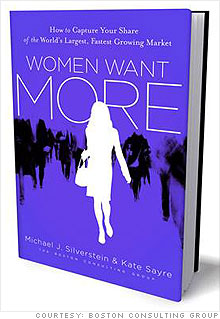The female economy: What women want
Women control half the wealth in the U.S., say the authors of the new book Women Want More - so why are companies still ignoring them?
 |
| Michael Silverstein |

NEW YORK (Fortune) -- Women account for 64% of the $18.4 trillion spent annually on consumer goods around the world. Pretty soon more women will be working in this country than men. Women already control half the wealth in the United States, and they will be responsible for roughly $5 trillion in additional earned income globally over the next five years. Welcome to the dawn of the female economy.
And yet many companies are ignoring, downplaying, or patronizing this fast-growing group of consumers. That's one of the key findings in a new book by the Boston Consulting Group's Michael Silverstein and Kate Sayre called Women Want More: How to Capture Your Share of the World's Largest, Fastest-Growing Market.
Silverstein, a former journalist and close cultural observer whose previous books include Trading Up: The New American Luxury and Treasure Hunt: Inside the Mind of the New Consumer, talked with Fortune about Women Want More, which is based on the findings of a survey of more than 12,000 women in 22 countries. (To take the survey, click here.)
What types of companies are the worst at appealing to women?
The three categories (as ranked by women) in descending order of dissatisfaction are financial services, health care, and consumer durables such as cars, electronics, and appliances. In all three categories, the providers effectively diss women.
Almost every financial services firm has a high-ranking female executive who's in charge of their women's initiative. But without exception they are all misunderstanding what is the appropriate way to speak to women. They think if they provide women with a cocktail hour and a chance to have a conversation with their peers, that creates a product and service that works for women.
They don't have a female-driven market research function. They don't calculate the share of affluent females. They don't have a marketing program that says, I'm going to understand your needs and configure products, and services to meet those needs, and explain them to you in language that you can understand.
Can you give some specific examples?
Women don't buy life insurance -- because no one is trying to sell it to them. Most men have life insurance outside of what they get at work. Women do not. Yet the economic catastrophe of a woman dying when she has young children to support is as great as it is for a man.
How about in the non-financial arena?
Air-conditioning repairmen still talk down to women. So do car dealers. Water heaters are considered an item of mystery and intrigue. Moms manage 85% of health care purchases, yet doctors show little respect for her time. They make her sit in waiting rooms for hours.
Despite women's growing financial power, they still earn about 68% of what men earn. But that income gap is closing. Can you talk about that a bit?
In 28% of two-income U.S. households, she makes more money than he does. If you were to stop 100 people ages 25 to 30 in Manhattan, more than half the women would make more money than the men. There are 1 million high-income women in the U.S., earning more than $250,000 a year.
What is the "crater effect"?
It contributes to the disparity in pay. She's making more money than he does right out of college. Then she has a baby, and she's still making more money. But there's some percentage of fast-tracking women who drop out of the labor force. And there are no 17 months of paid parental leave (like in Sweden) and no easily available, inexpensive day care.
She falls behind. Then when she tries to re-enter the workforce, there is no guarantee that the job she left is available to her at comparable pay, and often she has to drop down in pay. One reason why women have less secure retirements is there are these eight-to-20 years where they've been "cratered" out of the work force.
What were some of your most surprising findings?
Women rank pets, sex, and food -- in that order -- as the things that make them happiest.
The No. 1 thing women want more of is time. (Money and love rank second and third.)
When asked, "What can your husband or partner do that would make you happier?" they responded: Take me on a date, do a chore at home, and listen to me without solving my problem.
When are women most happy and least happy?
Women who are young and single are happiest. Then they get married and they are less satisfied. Then they have their first child and they are at the bottom of the V-curve. They only come out of it when their child grows up slightly and is not 100% dependent on them. Their happiness becomes close to but not equal to their single days 20 years later.
What impact will the female economy have on our lives?
The balance of power will change in favor of women, and so will the way products are developed and marketed. Women will gain share in politics and have more say over the political agenda. The female economy will contribute to leading the world out of the economic crisis. ![]()
-
 The retail giant tops the Fortune 500 for the second year in a row. Who else made the list? More
The retail giant tops the Fortune 500 for the second year in a row. Who else made the list? More -
 This group of companies is all about social networking to connect with their customers. More
This group of companies is all about social networking to connect with their customers. More -
 The fight over the cholesterol medication is keeping a generic version from hitting the market. More
The fight over the cholesterol medication is keeping a generic version from hitting the market. More -
 Bin Laden may be dead, but the terrorist group he led doesn't need his money. More
Bin Laden may be dead, but the terrorist group he led doesn't need his money. More -
 U.S. real estate might be a mess, but in other parts of the world, home prices are jumping. More
U.S. real estate might be a mess, but in other parts of the world, home prices are jumping. More -
 Libya's output is a fraction of global production, but it's crucial to the nation's economy. More
Libya's output is a fraction of global production, but it's crucial to the nation's economy. More -
 Once rates start to rise, things could get ugly fast for our neighbors to the north. More
Once rates start to rise, things could get ugly fast for our neighbors to the north. More







